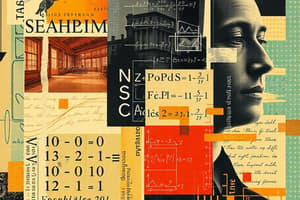Podcast
Questions and Answers
What is the first number in the Fibonacci sequence?
What is the first number in the Fibonacci sequence?
- 1.618
- 2
- 1
- 0 (correct)
What does the Golden Ratio approximately equal?
What does the Golden Ratio approximately equal?
- 2.618
- 3.14159
- 1.414
- 1.61803399 (correct)
Which statement is ambiguous in mathematical language?
Which statement is ambiguous in mathematical language?
- A number is seven times another number.
- Two consecutive numbers have a difference of 1.
- A number is not less than five. (correct)
- The product of two numbers is 42.
Which mathematical expression represents 'Four times a number plus five'?
Which mathematical expression represents 'Four times a number plus five'?
What is an example of using mathematical symbols in defining a number?
What is an example of using mathematical symbols in defining a number?
Which of the following is NOT an example of a mathematical statement?
Which of the following is NOT an example of a mathematical statement?
In the language of mathematics, how is 'eight less than a number' expressed?
In the language of mathematics, how is 'eight less than a number' expressed?
What represents the mathematical operation 'one-half'?
What represents the mathematical operation 'one-half'?
Flashcards
Fibonacci Sequence
Fibonacci Sequence
An infinite sequence of numbers starting with 0 and 1, where each subsequent number is the sum of the two preceding ones.
Golden Ratio
Golden Ratio
A special number approximately equal to 1.61803399, often denoted by φ (Phi).
Rational Number
Rational Number
A number that can be expressed as the fraction of two integers; for example, one-half is rational.
Inequality Representation
Inequality Representation
Signup and view all the flashcards
Consecutive Number Difference
Consecutive Number Difference
Signup and view all the flashcards
Sum Representation
Sum Representation
Signup and view all the flashcards
Product Representation
Product Representation
Signup and view all the flashcards
Increasing Value Expression
Increasing Value Expression
Signup and view all the flashcards
Study Notes
Mathematical Language
- Mathematical language uses precise and concise symbols to avoid ambiguity.
- It uses symbols for numbers, letters, binary operations, and special characters.
- Examples of mathematical expressions include: one-half, a number is seven times another number, a number is between -3 and 8, the square of a whole number.
- Mathematical language is precise, concise, and powerful for communicating ideas, avoiding ambiguity.
Fibonacci Sequence
- A Fibonacci sequence is an infinite sequence of natural numbers.
- The first value is 0, the second is 1.
- Subsequent numbers are obtained by adding the previous two numbers in the sequence.
Golden Ratio
- The Golden Ratio (φ) is approximately equal to 1.61803399.
- It's calculated as a/(a+b) = b/a, where 'a' and 'b' are two parts of a whole.
English Language Problems
- English language sometimes lacks precision and conciseness leading to ambiguity.
- These issues are common in mathematical communication.
Mathematical Symbols
- Mathematical symbols used include numbers, letters, binary operations (like addition, subtraction, multiplication), and special characters.
Language of Mathematics
- Provides clear, unambiguous ways to express mathematical concepts.
- Uses concise notation to express complex ideas.
- The language helps to clarify statements, aiding communication.
Importance of Mathematical Language
- Helps to understand expressed mathematical ideas.
- Allows for communication between individuals about mathematical ideas.
Characteristics of Mathematical Language
- Precise: avoids ambiguity.
- Concise: conveys information effectively using few words.
- Powerful: allows to represent/communicate effectively.
Logic
- Used to determine the validity of arguments.
- Propositions are statements that express a complete thought.
Connectives
- Connectives like conjunction (and), disjunction (or), implication (if-then), and biconditional (if and only if) join propositions.
- The rules for interpreting statements involving connectives are important (e.g., "and" means both statements are true, "or" means at least one is true).
Types of Connectives
- Conjunction: (AND) - True only if both sides are true
- Disjunction: (OR) - True if either side or both sides are true
- Implication: (IF-THEN) - False only if the first side is true and the second side is false.
- Biconditional: (IF AND ONLY IF) - True only if both sides have the same truth value.
Truth Value
- Used to describe the truth or falsity of single statements or propositions.
- Can be either true or false.
Truth Table
- Used to depict the truth value of compound statements composed of simpler statements.
- Shows all possible combinations of truth values and their outcomes.
Inductive Reasoning
- Reaches general conclusions based on specific examples.
Deductive Reasoning
- Reaches conclusions by applying general assumptions/procedures.
Types of Reasoning
- Inductive and deductive reasoning are the two main types of reasoning.
Statistics
- The science of collecting, organizing, summarizing, analyzing, and drawing conclusions from data.
- Two major branches include descriptive and inferential statistics.
Variables
- Numerical variables can be ranked or ordered (e.g., age, height).
- Categorical or qualitative variables are non-numerical and can be grouped into categories (e.g., gender, color).
Levels of Measurement
- Nominal: categories without order (e.g., colors)
- Ordinal: categories with order (e.g., rankings)
- Interval: ordered with equal intervals but no true zero (e.g., temperature in Celsius)
- Ratio: ordered with equal intervals and a true zero (e.g., height, weight).
Inferential Statistics
- Used to draw inferences or conclusions about a population from a sample.
Studying That Suits You
Use AI to generate personalized quizzes and flashcards to suit your learning preferences.



